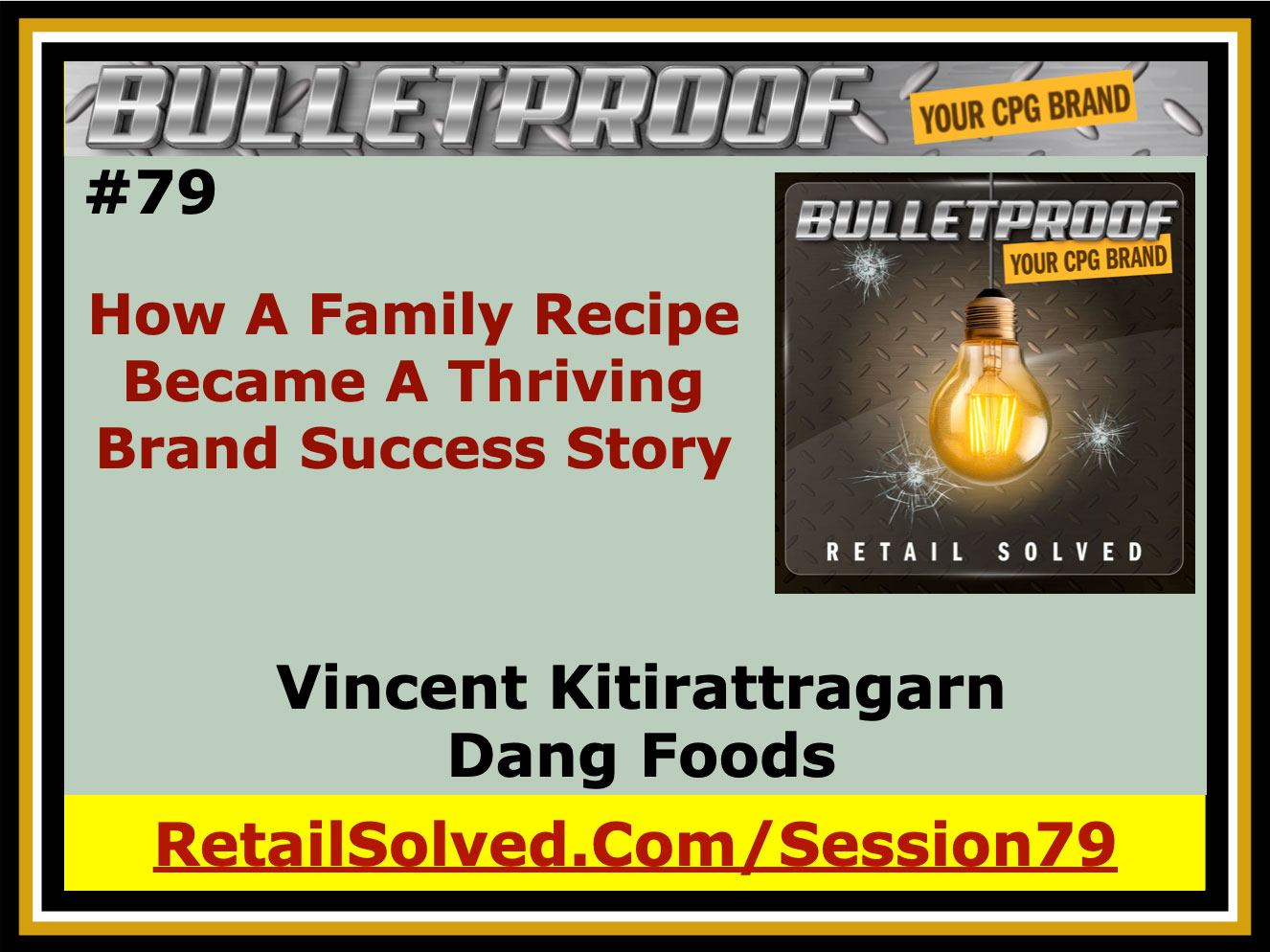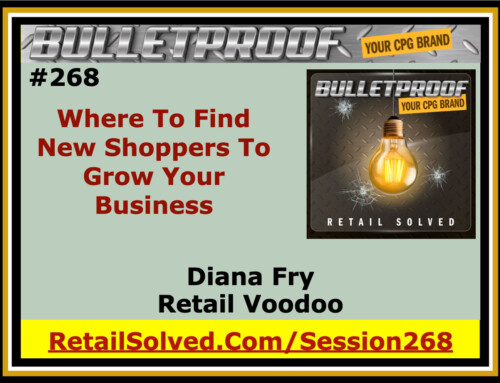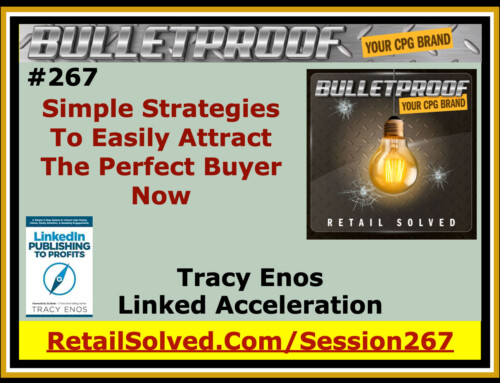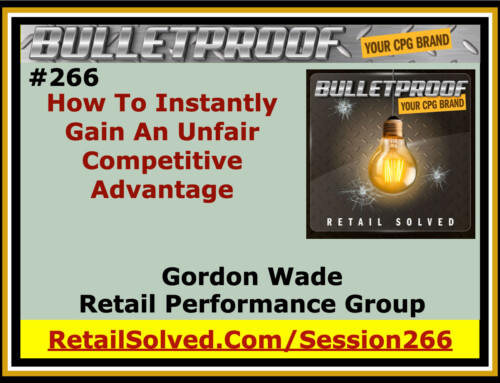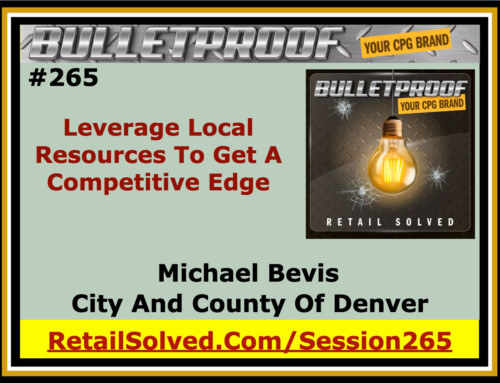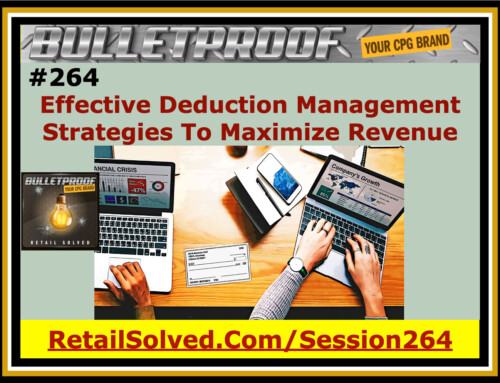Explore the journey of a family recipe as it transforms into a thriving brand with proven strategies for retail success. Vincent, founder of Dang Foods, discusses how he turned a family recipe into a thriving business. Dang Foods, known for its coconut chips, pioneered a new category in the retail market. Vincent emphasizes the importance of data-driven strategies to defend their market position and provide value to retailers, ultimately increasing category sizes and sales.
Standing out on a crowded shelf is difficult for any brand. Disruptive brands find creative ways to gain distribution outside traditional categories. Even more impactful is capturing the shopper's attention when they first enter the store.
Click here to learn more about Dang Foods
Click here to learn more about NatchCom
Listen where you get your podcast
Important: Brand Secrets and Strategies has been rebranded to Retail Solved. Please swap all BrandSecretsandStrategies.com URL’s with RetailSolved.com. This is now the Bulletproof Your Brand podcast. Thank you for listening! BRAND SECRETS AND STRATEGIES PODCAST #79 Hello and thank you for joining us today. This is the Brand Secrets and Strategies Podcast #79 Welcome to the Brand Secrets and Strategies podcast where the focus is on empowering brands and raising the bar. I’m your host Dan Lohman. This weekly show is dedicated to getting your brand on the shelf and keeping it there. Get ready to learn actionable insights and strategic solutions to grow your brand and save you valuable time and money. LETS ROLL UP OUR SLEEVES AND GET STARTED! Dan: Before I begin, I want to remind you that there's a free downloadable guide for you at the end of most every episode of my podcast. I will also try to include one easy-to-download, quick-to-digest strategy that you can instantly adopt and make your own, one that you can use to grow sustainable sales and compete more effectively. Remember, the goal here is to help you get your product on more retailers' shelves and into the hands of more shoppers. In this episode, we talk about the importance of social media. We also talk about the importance of having a strong digital online strategy to help enhance and grow your brand. Would you like an opportunity to learn from the very best, from Amazon, from Facebook, from Google, and other online platforms? Along with other industry thought leaders in this space, would you like to know how to bake these strategies into your brand's DNA and propel your growth? I have a special deal just for you. NatchCom is coming up. It's going to be October 5, 6, and 7. This is where you're going to hear from the experts. This is where you're going to learn how to use these strategies to help build your brand. I have an exclusive deal for every listener for this podcast. I worked out a special deal to get you 10% off this year's conference. You can go to the website and register at CMS10. That's CMS10. You go to natchcom.com to register. I'll be sure to put a link to it on the podcast webpage at the end of the show. Today's story is about how someone took a family recipe and turned it into a thriving business and how they carved out a unique niche within the retail store, how they were able to get the retailer to help support the growth of their brand. And the reason they did it, the way they did it, was by providing tremendous value, tremendous additional value beyond other brands. They saw an opportunity to help the retailers add profitable dollars to a category that needed a little more flavor, a category that was the gateway to the rest of the store. Today's story is about how a young brand saw an opportunity to create a whole new thriving category, a category that was eventually copied by a lot of other brands. They say that the best form of flattery is to have your product copied. What you're going to hear here in this episode is how this brand innovates to constantly stay ahead of the competition, to constantly remind the retailer that they're different, that they're a value-added product on the shelves. Here's Vincent with Dang Foods. Hi, Vincent. Thanks for coming on today. Can you start by telling us a little bit about yourself and your journey to Dang Foods? Vincent: Sure thing, and thanks for inviting me on. I started out in New York City. That's where I grew up. Both my parents are Thai immigrants. They came to the U.S. for grad school. I kind of started my career doing sustainability work, so helping large institutions buy more environmentally, socially preferable products. I worked with the City of New York and I worked for a number of start-ups and then made my way to San Francisco, and started doing a pop-up restaurant on the side, because I wanted to get involved with food, and I thought that there was a lot of opportunity with particularly Thai food in the U.S. So I did a pop-up restaurant, and the second one I did, my mom gave me a recipe for Thai lettuce wraps for it that had an ingredient toasted coconut that we used for our very first snack at Dang. So I kind of did a number of ... Tried it and experimented in a number of ways in the food industry, and the iteration of Dang as a snack company was the one that ended up taking off, so I kind of stuck with that. And that was six years ago. Dan: Yeah, and I've watched you grow. I actually did a project for you, so I've had the privilege of getting to know you over the years and watch what you've been able to do, and it's amazing how you've been able to carve out that really unique space. We love putting them on salads. So talk a little bit more about your product and what's unique about it, because your recipe that your mom gave you ... I remember when I talked to you once before. You really went into depth about the origin of the recipe, where it came from, and I thought that was really fascinating. Vincent: Yeah, so our coconut chip line is what we're best known for. And when we first launched, it was just one SKU. It was one flavor and a couple different sizes. And we quickly learned that we needed to have an assortment of different coconut chips on the shelf. So that's what we did over the first couple years. But coconut's a category, you go back six years, it didn't exist, right? Dan: Mm-hmm (affirmative)- Vincent: There was nobody selling coconut chip snacks. And so we had a lot of education to do to educate buyers and consumers and everybody, the media, to kind of explain to people, "Okay, this is literally how you eat a coconut chip. You can either eat it as a snack, or you put it on top of your salads, yogurt, and ice cream. You can bake with it. You can put it in your baked goods." So we really had to learn the vocabulary of how to talk about the product, and then fast forward to where we are today, you had a lot of competitors come in and out of the category since we joined. But we are still the market leader today, coconut chips. Dan: You are. And I remember one of the things that we were discussing early on in that project is where to put it on the shelf. And I remember that was one of the biggest challenges, how do you develop a story around, like you said, helping the retailer understand that, no, you don't go with the salty snack, nut-type stuff in the snack aisle, but you add in different places. And so, anyhow, the fact that you've been able to carve out a unique space, love the fact that you're able to do that, and the fact that you're able to build your story around how consumers use it. One of the things that really intrigued me about the fact that you've carved out this new space, and they say that copying someone is your greatest form of flattery, and about a year or two after you launched, all of a sudden at Expo West, there were a lot of coconut chip companies to your point, and most of them are gone. So how has that been, not only defining a category, not only carving it out, but defending your turf, and trying to defend your legacy? Vincent: Yeah. That really starts with a data story of, once you're on-shelf, the question is how fast do you move off-shelf. So we've been pretty liberal with investing in getting data that shows, this is how we do against our competitors, this is how we do in different categories, this is how we do in produce versus salty snack. So in a way, we see ourself as playing a role of a category captain. Dan: Mm-hmm (affirmative)- Vincent: Even within the relatively smaller category size of coconut chips. So yeah, at the end of the day, lots of people will come in, but the retailer really wants somebody who's going to help move off the shelf, help them increase their category sizes in the store, so that's the role that we play. Dan: Thank you for saying that. I tell people that, I've been telling people that for years. You are more than just an ATM machine to a retailer. If you can go into a retailer and provide real value to the retailer, that's how you stand out on-shelf, that's how you get the incremental merchandising. And the fact you're able to do that makes so much sense. And so anyone listening, you've got to get engaged with the retailer. You just can't show up with your product and say, "Hey, I've got a really neat recipe, and it's really creative and really cool," and hope to heck that the retailer's going to put it on the shelf. So I remember when we were talking years ago about where to put your product, and you had some luck in produce and you were trying to decide, do I go into the snack aisle? My recommendation was that you start in produce, because produce is the gateway to other categories. And by leveraging your brand's story to the retailer in produce, that is the natural segue into other areas of the store. And so teaching people how to eat healthy, that's where they typically learn or where they start experimenting with organic and other healthy, better-for-you products. How have you been able to bake that story into your selling story, that message into your selling story, and then leverage that with retailers? Vincent: The fact that we are going into produce first? Dan: Yeah. Vincent: So the rule of thumb that we take is the more conventional the store, the more I want to be in produce, because the more I want to be on the perimeter. Eighty percent of people, they walk into a store, and they go straight to produce. Dan: Right. Vincent: So you're going to get a lot of eyeballs there. You have higher rings for snack items. You're next to produce, which has higher rings, and people have this mindset of healthy snacking when they're looking at fruit. So not all retailers embrace this kind of thinking. There are definitely some that don't want snacks in produce, but we've been pretty successful in the ones that have, showing them that we're incremental to that produce side of the business. Dan: Well, and that's the nature of the beast. I mean, the fact that if you can add dollars to an existing category, that's what every retailer is looking for, and sort of back up and unwind this a little bit, the value of your customer walking into the produce section is greater than the value that's the value in terms of the marketbasket value, what they spend as they check out of the store, than the customer that doesn't buy Dang coconut chips. And again, the reason for that is that you are impulse purchase at the beginning until they get to know and love you. And one of the things I really find fascinating is that retailers have been able to find creative ways to merchandise you in front of the salad bins or in front of other produce tables. And that to me seems like an incremental merchandising opportunity that you're getting because they see the value of putting your product on the shelves. Your thoughts? Vincent: Yeah, so I agree with you that us being in a nice stand-up pouch gives us a lot of more opportunities than if we were in, say, a [inaudible 00:10:16] pouch, or in, say, like a [inaudible 00:10:18] bag. So I completely agree with you that ... Like they want to put something in front of customers that is a little bit edgy, a little bit more interesting, a little bit more different. And then, we've done a lot of working with store-level folks and managers and so on in order to earn their trust in order to get some of that space, so it's just not easy to get, but ... Yeah, and it really needs those decisions to make ... Or are made at the store level. And we really try to cultivate that and those relationships. Dan: Do you still do a lot of demoing? Vincent: Yeah, we do with new products. And I kind of see demos as it's an awesome way to get the product in the people's mouths. Dan: It is. Vincent: Ever since the beginning, our whole marketing plan was, "Get the product in people's mouths." And [inaudible 00:11:06] is not that much different in taste. We had this really dry trial, so, I use demos now a little bit more as somewhat of a bargaining chip in order to get other incremental, potentially displays, promotional activity. So just ways, really, to get something else. I try not to do demos just for the sake of it, and it does help around convincing buyers to take on a new product or to give you some kind of big promo. So that's kind of how I use it these days. Dan: That's brilliant. The fact that, again, you're providing additional value to the retailer, and again, everything's negotiable, and so being able to leverage the fact that you're going to participate in this program, you're going to go over and above what other brands would do, that's valuable to the store, because one of the things that I know that you're also really good at is your social media presence. So how do you leverage that story with doing the demo, as you said, a bargaining chip, to work with a retailer? How does that work? Vincent: Social media is interesting. I think, for retailers, they're all ... Every retailer now is super interested in getting the millennial consumer. They feel like they're losing the millennial consumer to e-commerce. And if you have a large social media following, it can show them, "Hey, this is my consumers, 80% female. Hey, look at them, they're in New York, they're in LA. Hey, look, they're 21 to 35, exactly the same age of the people you want to attract to your store." Dan: Right. Vincent: That's great, right? That's fantastic data to show a retailer, because they're going to say, "Oh, if you can get that person to pick up a bag, it's going to help my ring, it's going to make me look good, because you're bringing millennials into my category." So social media can be used in a number of different ways, so we see it as a way to really galvanize our base, like the core believers, the people who are really the brand evangelists who are going to talk to other folks. So that coupled with e-commerce, I would say, are the biggest opportunities for social media in CPG. Dan: Well, and one of the things I think a lot of brands don't realize ... There's the argument before was should I be in traditional retail or e-commerce, one or the other, not both. You got to have both. And the great thing about being in e-commerce is that you can do a lot more, get more run weight, as it costs you as much to get on a retailer's shelf, et cetera. And then you can leverage that relationship with your like, like you said your brand evangelists to help drive sales within a store. And so a combination of the two is a perfect solution. So what do you find really works best for you in terms of what strategies, when you're using e-commerce and using the numbers and working with retailers? Vincent: So for e-commerce, I think, the strategy that works, the approach that we take is we ... We pretend we're scientists, right? Dan: Mm-hmm (affirmative)- Vincent: And we're trying to find ... We have a hypothesis of, "Hey, we think maybe running these ads might work." Right? And so we set out to test the hypothesis, "Hey, these ads might work." And then we do a number of tests, and then we find out whether it works or not. And then from there, we go on and do more tests. And it's just constant tweaking that is required on e-commerce, because there's so many opportunities to get in front of customers that you like really you've got to find the best one that works for you. We end up spending a lot of our dollars on Amazon search, sponsored searches on Amazon, because that is our biggest e-commerce customer. And to be honest, like, Amazon does things better than almost everybody else in e-commerce. So why not lean into them as your preferred e-commerce outlet? Dan: Sure. Vincent: And spend the dollars on that. And the other thing is, you'll see exactly where those dollars are going. It's a lot more transparent than, say, the CPG retail grocery world. Right? Where it takes six months to know whether or not your promotion even ran and how it did and all that stuff. So I really like the immediate feedback. Dan: Well, and in natural, it's even more difficult, so it's great that you can do that. One of the things we should've pointed out is that you are, by trade, or I should say, by education, an engineer. So all this getting into the weeds of the numbers and the split testing the hypothesis, this is right up your alley. So that's got to be- Vincent: Yeah, yeah. I hopefully learned something in college that I can apply here. Dan: I was just going to say, so you could say, "Look, mom! I'm using my degree!" Vincent: Yeah. I'm actually not a very good engineer, but better food person. Dan: Well, you engineered a chip. Vincent: Yeah, some of that stuff applies. Yeah, food engineering, I guess. Dan: Well, it all works. That's great. So, let's back up a little bit. When you were working in a restaurant, you said that didn't last very long. What did you learn from that experience, or what did you learn ... I'm looking at your LinkedIn profile. What did you learn as a research associate for the GoodGuide? What stories or what things did you learn as you were getting, before you started getting into Dang chips that you were able to apply? Vincent: That's a good question. One really good lesson I learned when running the pop-up restaurant was about forecasting, and I really messed up my forecast one day. The first time I did the pop-up restaurant, it took place at a nightclub in San Francisco, and they had just been featured in the New York Times, as, "Hey, look. This is an interesting place where people go and they eat at night, and it's underground." It's not underground, literally, but it's figuratively underground in that you have to pay $5 when you get in and sign a waiver saying you're part of this private club and as such, like, I don't have to rent kitchen space, I don't have to rent a commercial kitchen or get any kind of licenses. I could just cook at home. So it was really nice for some ways to get around the red tape, but also experiment with really interesting foods. So I was expecting 400 customers that night. And there was a line around the block. They told me to prepare 200. I said, "No, let's double it, because you guys were just in New York Times. That's going to really push a lot of people towards your event." And it did. Like there was a line around the block for that event. The thing is, not everyone could get in. So the place had a capacity of, say, 200 people or something, and a lot of people just ended up standing in line and walking away, or just basically not getting in. And I ended up only selling 200 servings of...That night I was baking a chicken steak burger. And so I wasted ... It pains me, I still remember having this vision of all these basically big bins of chicken that I had to throw away because I had over-forecasted, and then I didn't have very much [inaudible 00:18:06]. So that really taught me a lesson, that forecasting is super important. You don't want to be left with too little or too much. And to this day, we have a metric that we track here, which is months of inventory. We don't want to be too high or too low with that number. So somebody on the operations team, it's their number that they own. They have to make sure that it doesn't go below a certain amount. Dan: And that makes a lot of sense. Now, you're kind of fortunate that your product has a little bit more ... I would assume your product has a little bit more of a shelf life than some products. So as a result, it's not critical for you, whereas produce, the other items that you're next to, they might only have a week or two shelf life. So how does that relationship between what you're selling and getting in the store and getting it on the shelf, how do you manage all that? Vincent: Well, it's nice that we do have a long shelf life. So we have about 12 months of shelf life. And we are importing our snacks from overseas, so it takes six weeks, give or take, from the supplier's door to our warehouse. And so basically once it comes to our warehouse, we try to move it as quickly as possible out of that warehouse through sales to retailers. And then if we have to go to [inaudible 00:19:22], we go to that. The whole point is, we have a lot of product on the end, we want to make sure a lot of it's going out, it's not just sitting there. When it's sitting there, that's just ... You have cash tied up. At any given time, if you have a million dollars of inventory, that's a million dollars that's not in your bank that you're not using to spend to grow the business. Dan: Well, and on that note, that's exactly why I asked that question, because I know that you source from overseas, so what happens if a shipment is late? I mean, you don't want to be caught without product. That's certainly not a good thing. So how do you adjust for that? How do you accommodate that risk? Vincent: Yeah, I mean, you have to have a buffer, so we typically have a month or two of buffer of inventory in case we get a large PO unexpectedly or in case there is a delay at ports or a port strike, which has happened in the past. You have to kind of plan for contingencies. Dan: Gotcha. And by the way, had a great conversation with John Sebastiani. We were talking about you. Loves the brand. And it's great that he's involved and he's really engaged with you. So what is it like working with Sonoma Brands and what have they taught you? How do they help you grow your brand? Vincent: Yeah. The group that he's running came from Crate. It was a group of big retailers running [inaudible 00:20:32]. And so they kind of downloaded towards us their playbook of sales strategies and marketing strategies on how they grew the Crate brand, so ... Yeah, we got a lot of really good, interesting insights into field marketing, into brand ambassadors and celebrity ambassadors and they did a really great job there at building that brand, and we're trying to take stuff that can apply for us and apply it here again. Dan: Well, and I appreciate your sharing all of this. Now, the next thing I really wanted to do is give you an opportunity to talk about your innovation. As you mentioned earlier, that's one of the things that differentiates you from the competition, from the copycats, one, and two, it gives you a new something to drive sales, something to drive excitement into the category, or into the brand. So how do you manage your innovation? How do you come up with things? And then where are you at in terms of some of the innovation? And I know you're just launching a new product now. Vincent: Yeah, so, innovation is what I spend a lot of my time on. I do think it's one of the best managements to grow a company, and I do think it's something that has ... As a company grows, it has to be kind of done very, very thoughtfully. So it really starts with, as a brand, what do you stand for? What are your guardrails, right? And for Dang, we want something that's modern, so something that's innovative, something that's minimalist and clean, something that's on a trend. We want something that's Asian-inspired. That's the second one. And so using Asian flavors or ingredients, and then, the last one is it has to be a snack. So using that guardrail, that's kind of targeted in on the biggest opportunities that might present itself. You know, coconut chips, sticky rice chips, which is our second line. They came about because of ... We either found them in Thailand or were inspired by an ingredient that we found there, and we were like, "Hey, this should exist in the U.S." It always kind of starts from, "This should exist," right? And so that mentality is, "Hey, I want something that solves a problem for me." It's going to solve a problem for millions of other people, as well. And so that's where the sticky rice chip, that's where the coconut chips came from. And then similarly, for looking forward, we're working on a bar product that has some of that same DNA of, modern, innovative ... It's a keto-friendly bar. This came from a personal pain point of me being on the keto diet, which is a high-fat, moderate-protein, low-carb diet, and not having enough on-the-go snacks. And keto diet is absolutely on fire right now, and we've been working on this for about a year. And so we're looking forward to launching it soon, but this particular bar is meant to hit that pain point of something that tastes good, but is keto friendly, and then you can take on-the-go. So I'm really excited about it and looking forward to launching it. Dan: So are you going to launch it at Expo East? Am I going to get to try it? Vincent: We're actually not going to Expo East this year. Dan: Oh, no! Vincent: We've already sold it into some retailers, but this particular item is going to be great in the national channels, launching into Whole Foods in January nationally. So they see what we see as far as the trend around keto, and there not being enough products there. They said they got a lot of submissions for keto bars, but ours hit the right combination and flavor and texture and price point, and so they're really getting behind it in a big way. So you're going to see some activity there early in the year from us, but also e-commerce. Bars are a great e-commerce item. They're small. They're compact. They don't weigh a lot. Dan: No. And actually, I was going to ask you about that, so thank you for bringing that up. I saw that on your signature line, and I was wondering what that was about. My wife's on the keto diet, and she just absolutely loves it, and it reduces inflammation, and she feels better, and it's something I want to start doing pretty soon as well. Vincent: Yeah, I mean, so what you probably saw on the signature line was a link to our Indiegogo campaign. So we did a crowdfunding campaign, which we're about to finish. We're raising $20,000, and it's going to finish this week. And it's our way of kind of testing the market and also getting really, really passionate keto customers, keto fans, behind our product even before it launches. So, yeah, we learned a lot from this process. Now one thing that we are going to be doing is changing the name and bringing it closer to Dang brand. So we actually did some A/B testing, and showed people Dang Bar versus what we'd put on Indiegogo was FATBAR. And there was more brand affinity force for Dang Bar. Dan: Well, absolutely. And that was actually the next thing I was going to ask you. So when you're doing all of this testing and tweaking and stuff, how do you manage that? Let me rephrase that. How do you know that you've got the right flavor, the right mix of everything? Do you have a group of brand evangelists that you can reach out to and give samples to? So what is your strategy, how do you do that? Vincent: So when it comes to consumer panel testing, we actually work with some universities that do a good job of getting a sample that we're looking for. So people on a certain demographic or a certain race or certain age, certain gender. And they put this in front of them, about a hundred or so, and they give us the results, and it shows us what's statistically significant, because that's very important. It has to make sure that the results are statistically significant to be able to extrapolate it to a larger population. So, yeah, we work with that, but a lot of this testing, what I was talking about, can be done within a couple days, just by Facebook ads or just by using something like Survey Monkey. And so, yeah, that's kind of how we do tests. Dan: It makes a lot of sense. Well, I appreciate your sharing that. So one of the things, Vincent, that I started doing on the podcast just recently is asking you, my guest, if there's any problem I can help you solve. Anything I can help you come up with that might help you grow sales and get your brand on more retailers' shelves and in the hands of more shoppers? Vincent: That's a good question. I mean, you're the category management guy. I mean, category management is one of those things that, as a small company, you don't always have the luxury of having a category manager or people with that expertise. That's always something that we try to imbue into people that work here on the sales and the marketing side, is we kind of talk about not just Dang as a brand or a product, but as a category. And so telling a category's story is important, and I think there's always ways to help each other out with that. Dan: Well, any question I can answer for you? Because this is exactly why I'm doing the podcast. And I don't know if you knew it, I launched a free turn-key sale story strategies course, which is designed to teach people how to begin telling your story. Now the reason it's free is because it's something every brand should be doing, even the big brands, although let's reserve it for the natural brands. That's where my heart is. But the point is this, if a brand ... If you can do what you're able to do as far as leveraging a selling story with a retailer, become an expert in your product, become an expert in your competition's product, become an expert in the retailer that you're working with, and then be able to build you story around that. And then start banking in the numbers and throwing in some of the survey information, et cetera. Then that's the win-win. And that's, by the way, that's also the reason for the podcast. Is there a specific question that I can help you with today? Vincent: Nothing specifically today. I always ... I know that you do a great job at taking data and synthesizing it into a nice story, and so, that's always in the back of my mind. We do have someone now who does serve as like a shelf analyst who's really. So that's somebody, she's the one that makes all of our decks and new on our team. She's fantastic. Dan: Well, I'm going to be offering additional training courses. In fact, actually, I'm just launching them now, where I'm going to be tackling specific problems. One of the things you'd talked about was your forecasting. And we got into that a little bit, so I'll be getting into trade marketing and how do you understand the data points and the data maze and some different things like that, so keep an eye open for that. Anything else that you want to share, anything else that we didn't cover today that you think is relevant or you want to share with the audience? Vincent: I don't have anything specific, but I will say that Dang is available in 13,000 stores. We are nationally distributed and just featured on Rachael Ray. Dan: Really? Congratulations. Vincent: Earlier this week, as one of their top items they're excited about. So, yeah, grab a bag. Dan: Oh, absolutely. And you've built a heck of a company. Again, we love them. They're a great product, and it's been great watching you grow and watching you build this brand over the years. So thank you for making time for us today. Thank you for coming on. And, I look forward to seeing you, I guess at Expo West at this point. Vincent: Yep. Sounds good. All right, see you later, Dan. Dan: Thanks, Vincent. I want to thank Vincent for coming on today. I'll be certain to put a link to Dang Foods in the show notes and on this podcast webpage. You can get there by going to brandsecretsandstrategies.com/session79. On this episode, we talked a lot about execution and the importance of forecasting and making sure everything is in place when you have a promotion, when you're launching a new product, and where you belong in the store. Today's free download is my retail scorecard. You can get it instantly by texting "retail scorecard" to 44222, or by getting it on the show notes on this podcast webpage. This will help you execute more effectively. This will help you avoid any of the mistakes that a lot of brands face in terms of making sure you've got the right product on the shelf, making sure that you execute flawlessly at retail, and making sure that you have enough product in the pipeline to be able to satisfy whatever your promotional needs are. As always, I appreciate you. I thank you for listening. I look forward to seeing you in the next episode. Dang Foods www.dangfoods.com This episode's FREE downloadable guide Scorecards are powerful goal setting tools. You’ve probably heard that “what gets measured gets done”. Scorecards map out objectives in bite-size manageable chunks that keep you on-track and focused. They're what you need to succeed. CLICK HERE TO DOWNLOAD YOUR FREE STRATEGIC GUIDE: Retail Scorecard Thanks again for joining us today. Make sure to stop over at brandsecretsandstrategies.com for the show notes along with more great brand building articles and resources. Check out my free course Turnkey Sales Story Strategies, your roadmap to success. You can find that on my website or at TurnkeySalesStoryStrategies.com/growsales. Please subscribe to the podcast, leave a review, and recommend it to your friends and colleagues. Sign up today on my website so you don’t miss out on actionable insights and strategic solutions to grow your brand and save you valuable time and money. I appreciate all the positive feedback. Keep your suggestions coming. Until next time, this is Dan Lohman with Brand Secrets and Strategies where the focus is on empowering brands and raising the bar.
Enter your name and email address below and I'll send you periodic brand building advice, tips and strategies.
Sign up to receive email updates
FREE Trade Promotion ROI Calculator:
Click Here To Maximize Sales And Profits
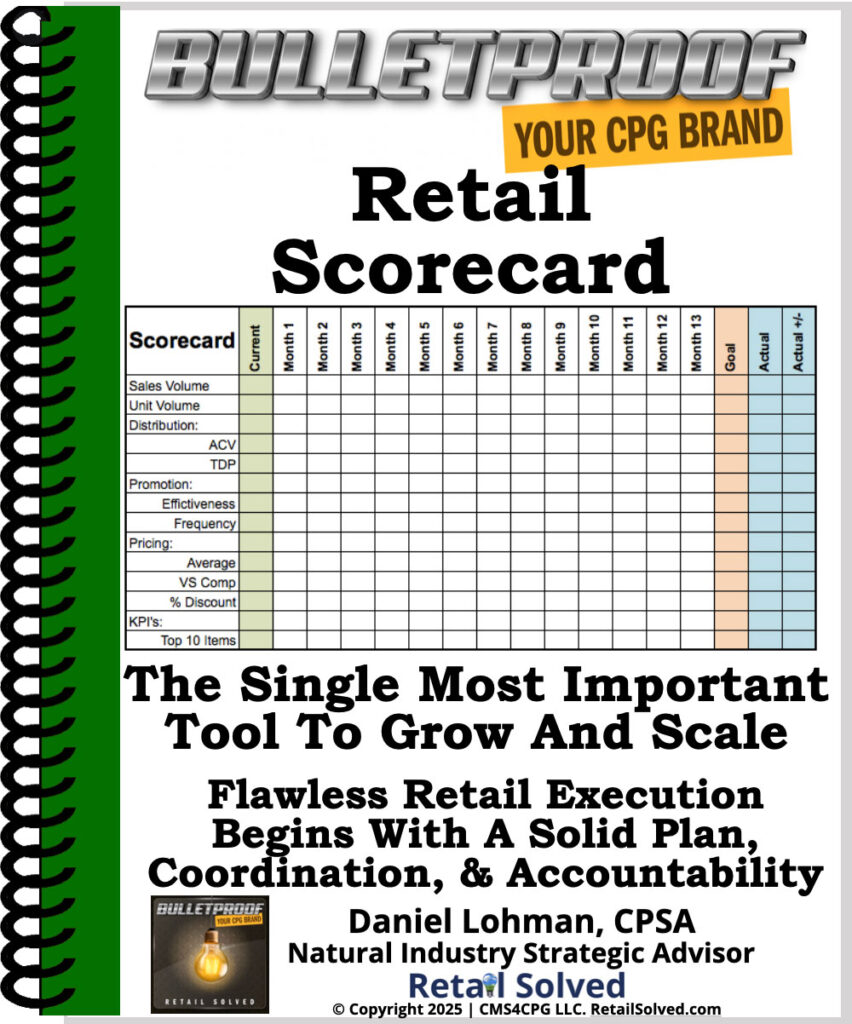
Retail Scorecard – Maximize Retail Execution
Want The Most Effective Tool To Maximize Retail Execution?
Exploit your competitions weaknesses by committing to this simple strategy that they overlook. Scorecards are the most powerful and underutilized project management and goal-setting tools that help brands achieve success by breaking down objectives into manageable chunks. Learn how to unlock their awesome power to gain a significant unfair competitive advantage. They’re what you need to succeed!
Image is the property of CMS4CPG LLC, distribution or reproduction is expressively prohibited.
